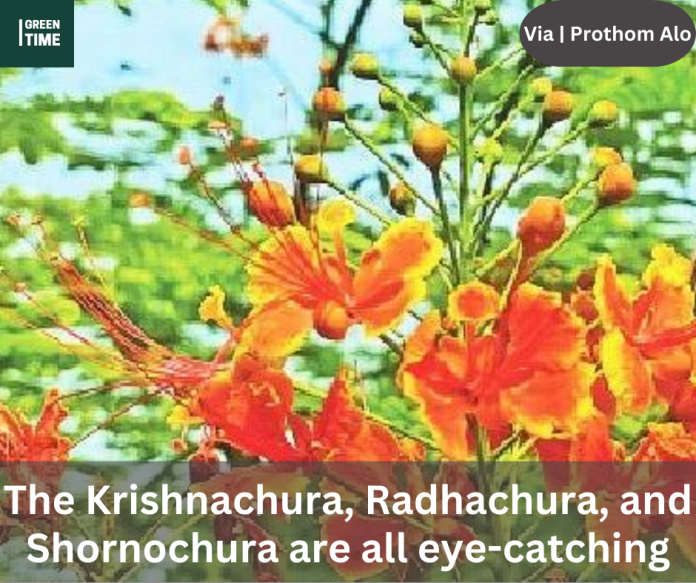In the midst of the summer’s intense heat, a waterfall of strange beauty emerges from nature. There are three types of flower streams flowing along Dhaka’s roads, including waterfalls. The crimson chura on the road next to Chandrima Lake; the golden yellow chrysanthemum, or Kankachura, on the Rokeya Sarni road on the east side of Jatiya Sangsad Bhavan; and the yellow-red Radhachura in front of Curzon Hall—these three summer flowers have brought a message of tranquility to the city.
If the car falls into a traffic jam while moving, then you can open your eyes and see these flowers in that gap, which will reduce the irritation a little. Recently, among these three flowering trees in Dhaka city, Kankachura appears to have expanded the most, with Krishnachura following closely behind. The Manik Mia Avenue road junction now boasts some Radhachura trees.

Often, confusion arises regarding the names of these three trees. How did the Madagascar tree Krishnachura get the Bengali name Krishnachura in our country, I did not find its history anywhere. Poet Michael Madhusudan Dutta dignified Krishnachura in his poetry, Rabindranath and Nazrul were not left out. In Hindi, people refer to both Krishnachura and Radhachura as Gulmohar or Gulmore. In the end, India adopted the name Gulmohar for Krishna Chura. The name Swarnachura was used by Nisargi Bipradash Barua in his book Vegetam Tarulata, another Nisargi, Dwijen Sharma, suggested the name Kanakchura in the Daily Observer newspaper. Gradually, the name Kanakchura became popular and established itself as a Bengali name. Radhachura is sometimes called Chota Krishnachura. Krishnachura and Radhachura, however, are two completely different trees. Krishnachura is a large tree, while Radhachura is a small shrub. Both trees’ branches are soft and break easily in the wind. Krishnachura branches break more than Radhachura during Kalvaishakhi. On the other hand, Swarnachura is a taller and stronger tree than Krishnachura, even if the small branches break in the wind, the big branches are not damaged, and the whole tree is not uprooted like Krishnachura.
All three plants’ fruit resembles a bean because they are members of the same leguminous family, Fabaceae. The botanical names of Krishnachura are Delonix regia, Peltophorum pterocarpum of Kankachura, and Poinciana pulcherrima of Radhachura. The leaf structure of the three plants is almost the same; only the leaf shape is different. The three plant species have compound leaves, arranged in a row on the two edges of a petiole. The growth, habit, appearance, and presence of flowers easily distinguish the three plants. The regal-looking Krishnachura is bursting with bright red flowers; Kankachura and Radhachura are like beggars, with golden yellow flowers blooming on the branches like the crown of a queen’s head. Their flowers bloom in inflorescences like tops on the branches, sometimes the colour of those flowers is mixed with yellow-red, depending on the variety, and sometimes it is pure yellow. He still tries to attract passersby with the swaying wind.
However, Kanakchura surpasses the other two cities in every aspect. Because all humans and insects are fascinated by the abundance and fragrance of this flower, the tree is also strong, long-lived, and expensive. Planting this shade on at least one of the two sides of the road can enhance the beauty of Dhaka and other cities.

